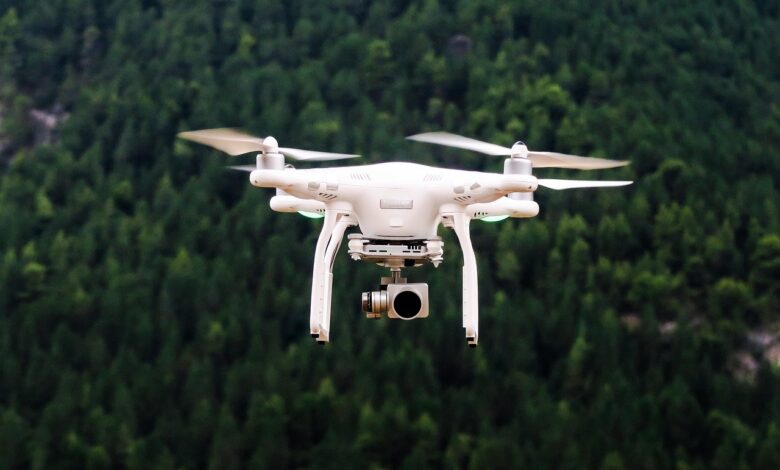Top 7 Drone Sensors Every Surveyor Should Know

Whether you have to create detailed topographical maps or obtain 3D imaging, the accuracy, quality, and reliability of your data depend on the type of sensor used. This makes it essential to understand the top types of sensors available for surveyors and what they offer.
Drones have become an indispensable tool for accurate, cost-effective data collection. However, mapping and surveys using a drone are only as effective as the sensor being used. This makes it essential to understand the strengths, limitations, and applications of the different drone sensors available.
Take a look at seven of the best drone sensors that are helping surveyors step up their work.
Why Surveyors Need the Right Drone Sensors
The reasons why surveyors need the right drone sensors are:
- High accuracy and resolution are required for modelling and surveys.
- Time and cost-efficient surveys based on the type.
- Ability to survey unsafe and difficult-to-access areas.
- Comprehensive data collection and monitoring for a wide range of sensor data.
- Enhanced data density and detail.
- Repeatable and consistent monitoring.
- Seamless software integration, such as UgCS.
- Supports 3D modelling and GIS applications.
- Improved project management and monitoring.
To avail all of these and more, it is important to have a sound knowledge of drone sensors and what they offer.
The Top 7 Must-Know Drone Sensors
Seven of the most efficient drone sensors for surveyors include:
1. LiDAR Sensor
LiDAR, Light Detection and Ranging, measures distance by using laser pulses that are reflected back by an object (the topology in surveying). Thus, LiDAR captures high-density elevation data, operating at any time of the day, and can penetrate even the densest foliage. This method offers Color-rich 3D reconstructions for accurate visualisation. LiDAR modules compatible with DJI M400RTK can deliver high-accuracy geospatial surveys.
2. Photogrammetry Sensor
Photogrammetry overlaps images matched using pixel correlation. The resulting data is available as a Photo-based 3D model or an orthomosaic. This method is suitable for surveying large open spaces that have light to no vegetation cover, and can be done only when there is ample daylight. This basic feature is compatible with most devices, like the DJI M400RTK.
3. Multispectral Camera Sensors
Multispectral camera sensors are made of pixels sensitive to wavelengths and detect radiation belonging to the electromagnetic spectrum. These are used to record a variety of data for purposes like precision agriculture, environmental monitoring, mapping, surveying, surveillance, and fire detection.
4. Thermal Imaging Sensor
Thermal imaging sensors in drones capture infrared radiation data. Thus, it detects heat signatures for a range of applications such as hotspot surveying, search and rescue operations, infrastructure development, environmental monitoring, and disaster response. This form of imaging is supported by most, if not all, drones, like the DJI M400RTK.
5. Hyperspectral Sensor
Hyperspectral cameras are designed to detect hundreds of narrow spectral bands beyond a standard camera’s RGB capacity. However, this is a highly sensitive system where small errors can lead to distorted data. UgCS systems, with their automated mission planning and flight path optimisation, are designed to support hyperspectral sensors. They also increase data accuracy, protect sensitive equipment, and avoid costly reflights.
6. Magnetometer Sensor
Magnetometer sensors are designed for subsurface detection and underground utility mapping. These sensors work by measuring the magnetic flux density and detecting anomalies in the Earth’s magnetic field. When using a Magnetometer sensor, the survey grid is planned with UgCS. Then, the drone is used to capture aerial imagery.
7. GNSS/RTK Module
RTK (real-time kinematic) positioning uses GNSS satellite constellations (such as GPS and Galileo) to receive precise positioning data. These help surveyors obtain highly accurate imaging and reduce errors. This has become popular in mapping and surveys since it allows real-time improvements in geo tagging accuracy and reduces the need for ground control points (GCPs).
Comparing the Popular Sensor Types and Designs
The features of these drone sensors can be compared as follows:
|
Sensor Type |
What It Does |
Strength |
Limitation |
Best Use Case |
UgCS Integration |
DJI M400RTK Compatibility |
| LiDAR | Laser scanning for 3D mapping | High accuracy, vegetation penetration | Expensive and complex workflow | Topographical mapping | Yes | Yes |
| Photogrammetry | 2D images stitched to create 3D models | Cost-effective and scalable | Light dependent | Construction and urban mapping | Yes | Yes |
| Multispectral Camera | Detects multiple IR/visible light brands | Crop, soil, and environmental survey | Lower spatial resolution | Ecological survey | Yes | Yes |
| Thermal Imaging | Detects heat sensors | Search and rescue, heat leak detection | Low resolution | Utility and rescue | Yes | Yes |
| Hyperspectral Camera | Detects very fine spectral bands | High-resolution imaging | Large datasets, low resolution | Mining and environmental research | Limited | Limited |
| Magnetometer | Detects variation in magnetic fields | Finding subsurface detection | Magnetic interference | Geophysics and archeology | Limited | Limited |
| GNSS/RTK Module | Ensures real-time kinematic GPS location accuracy | Precision georeferencing and geotagging | Needs a base station | Precision mapping | Yes | Yes |
Table: Comparison Between the Different Types of Drone Sensors.
How to Choose the Right Sensor and Drone for Your Survey
To determine the type of drone sensor you require, the steps are as follows:
- Determine the purpose and objective of your survey.
- Determine the budget that you have to work with.
- Assess the environmental conditions in which the survey is going to be conducted.
- Evaluate the sensor weight and compatibility.
- Understand accuracy and resolution requirements.
- Evaluate integration and software support offered.
- Consider the versatility of the sensor being used.
Wrapping Up
From LiDAR and Photogrammetry to Hyperspectral and GNSS/RTK Modules, drone sensors vary in design, purpose, and accuracy. While selecting the drone sensor for surveys, it is important to evaluate its strengths, limitations, and what they offer. Based on these, determine the type of sensor you require.
Increasing Efficiency of Surveys with Drones
Ready to elevate the efficiency of conducting surveys? Upgrade to a drone sensor compatible with your system, or upgrade entirely to suitable drones like the DJI M400RTK.



